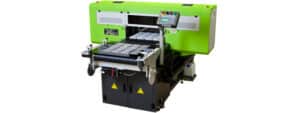The printing industry has been able to grow during the digital age, thanks to modernization and new innovative development. Despite the advent of social media and digital marketing, print remains a significant means of communicating messages as well as branding products. Over the past few years, billions of dollars worth of materials have been printed across the globe, demonstrating the matchless importance of the sector in global communication channels.
For many companies and brands that would like to outperform their competitors, investing in UV printing is one technique they can’t do without. The following sections explain how UV Printing works and its benefits marking it out as a future for both the packaging and printing sectors.

What is UV Printing: A Brief Explanation
An ultraviolet (UV) printer is a digital printing method that uses UV light to dry or cure ink immediately after it is printed on the surface. Traditionally, solvent-based inks were used for printing. However, UV printing employs UV-curing inks that undergo a photochemical reaction with the introduction of UV light and therefore change from liquid to solid almost instantly. It makes it possible to print directly onto different materials for easy customization of products.
The Mechanics: How Does UV Printing Work?
A number of key elements are involved in the process of UV printing that work together smoothly to produce high-quality prints. The printer ejects UV-cured ink onto the material’s surface, with UV lights following closely behind drying ink on contact. This ensures quick drying times and vibrant colors that last long, leading to eliminating waiting time for drying the ink. It releases minimal volatile organic compounds (VOCs) into the air when compared to traditional printing methods which rely on solvent evaporation. Hence, it is a safer and cleaner option both for the environment and operators.
Benefits of UV Printing
In comparison with traditional printing, UV printing offers several outstanding benefits. These not only benefit the printing company but also the customer as well as the environment. Let’s explore the significant benefits of UV printing below:
Versatile Printing
UV printing provides unprecedented versatility and therefore can be done on any material such as paper, plastics, acrylics, glass, timber, and metals. It is suitable for many industries including packaging, signage of the textile industry, or even electronics.
Fast Drying
The ink dries instantly because it undergoes an ultra-violet curing process hence enabling economical production time and quick order turnaround speed. This means that there is no waiting time for drying of the ink which often leads to smudge or smear in prints. Once you are through with printing, you can immediately start working with them.
More Color Options
UV printing comes in lots of color options including vibrant pigments that are highly visible. Thus this innovative technology enables precise and detailed prints that have superior image quality making it most appropriate for creating sharp and attractive pictures and designs.
Eco-Friendly
Another significant benefit of this printing method which is appreciated across the globe is its environment-friendly approach. Due to its limited negative impact on the environment, UV printers are considered a green technology. Moreover, no volatile organic compounds emissions are involved in UV printing production thus reducing energy consumption in line with sustainability approaches as well as environmental regulations.
Longevity
These prints do not fade away easily when exposed to sunlight; they do not scratch easily either. Hence, they offer better outdoor uses since the items undergo many handling or weather challenges.
Applications of UV Printing

UV printing can be effectively utilized in a broad spectrum of industries, which include:
Packaging
An industry where UV printing is extensively used to give vibrant and eye-catching designs on product packaging, labels, and shrink sleeves. They are ideal for branded packs since the prints are durable enough to withstand rough handling while keeping them visually appealing.
Textiles
The textile industry uses UV printing to create original patterns, custom designs, and graphics on fabrics and apparel. There is a bond between the ink used in the UV curing process and the fabric fibers that makes them last with time without losing their original color or brightness.
Electronics
In the electronics industry, UV printing is applied to print branding materials like logos as well as product information tags and warning labels on various electronic devices and components. Due to its high-resolution prints, there are no such problems as lettering being blurred or becoming illegible against different materials.
Automotive
In automotive manufacturing, UV printing processes have been used for printing logos, serial numbers, and decorative elements on car parts. Since they possess excellent adhesion properties as well as chemical resistance under various environmental conditions, they give perfect treatment to car brands as well as owners. Hence, UV printing has found applications in the automobile sector.
UV Printing vs. Screen Printing: A Comparison
UV printing and screen printing are both used for materials but the differences in several aspects of these printing processes:
- Color Options: UV printing has a broader range of colors compared to screen printing, with the best color accuracy.
- Drying Time: Unlike the case in UV print, additional drying time is required for screen prints.
- Versatility: This type of print can outdo screen print in terms of material printed on and surfaces.
- Environmental Impact: On the other hand, it is known that location-based services produce low VOCs, which makes them excellent for environmental sustainability as opposed to traditional screen prints.
Conclusion
In summary, there are a lot of advantages that come with using UV printing as compared to standard forms of printing. This makes it an ideal choice for businesses that want top-notch quality and flexibility in their output. The ability to dry instantly which offers vibrant color choices and environmental friendliness sets UV printing apart from other conventional methods making it very important in commercial package designing as well as textiles and electronics.